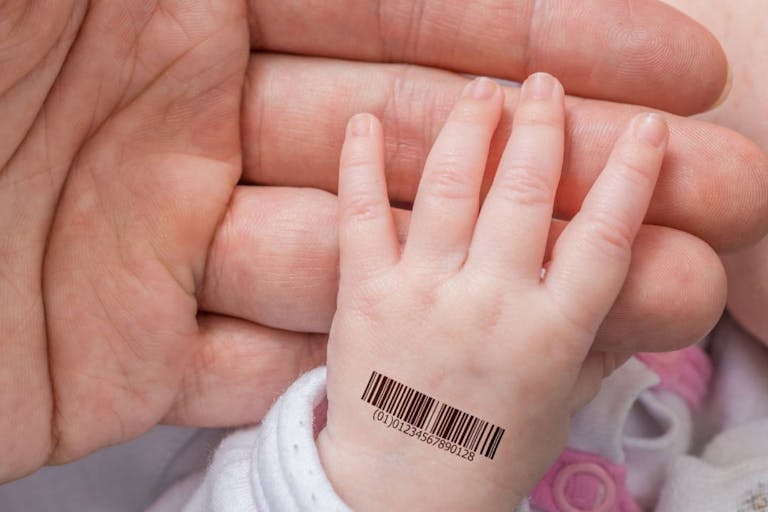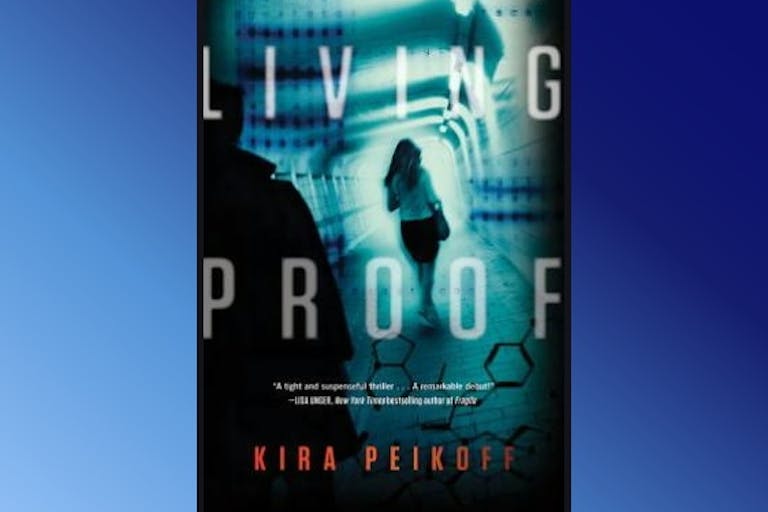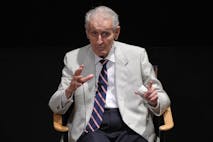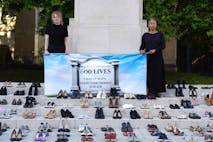
Why more regulation won't solve the ethical IVF crisis
Angeline Tan
·
Review of Living Proof by Kira Peikoff
It was during the 2004 presidential election, but I remember it as though it was yesterday. Less than a week after actor Christopher Reeves’s death, Democratic vice presidential nominee and ladies’ man John Edwards ascended the stage to get the most mileage he could from Superman’s yet-unburied corpse. In the unmistakable ringmaster-cum-faith healer style typical of Southern demagogues, Edwards mustered up one last pitch for his peculiar brand of snake oil: “If we do the work that we can do in this country, the work that we will do when John Kerry is president, people like Christopher Reeve are going to walk again! Get up out of that wheelchair and walk again!”
Sen. Edwards was shilling the unlimited potential healing power of embryonic stem cells, which were all the rage back then. Edwards was targeting then-President George W. Bush’s threatened vetoing of any congressional legislation that provided federal funding for embryonic stem cells in medical research. If only evil Republican President George W. Bush hadn’t prohibited federal dollars from funding embryonic stem-cell research, scientists wouldn’t have to be shackled by the chains of not forcing the taxpayer to fund their research projects. For some weird reason, known only to him, President Bush believed that killing embryos for spare parts to alleviate the suffering of already born people was some kind of ethical contradiction.
It was only a short time later, in the midst of Bush’s second term, that author Kira Peikoff, according to the dust jacket blurb, “watched President Bush announce the first veto of his presidency to deny federal funding for embryonic stem cell research.” From this incident came the inspiration for Peikoff’s debut novel, Living Proof. In the novel, Peikoff presents a dystopian future depicting how chilling life in America could soon become if pro-lifers had their way and imposed their theocratic views on an unwitting and unwilling American public.
It is 2027, the year of Our Ford. Dr. Arianna Drake runs a fertility clinic in lower Manhattan, where she assists couples whose fecundity is less than fully operational. However, because Christian fundamentalists have taken over the government, and had put embryos off-limits to research in 2011, Drake’s inventory of frozen embryos is heavily monitored by the state’s Department of Embryo Preservation (DEP), which holds the power to revoke Drake’s license and imprison her should even one embryo go missing. (Am I missing something here, or has the editing at sci-fi publishing houses like Tor gotten so sloppy that it puts future draconian legislation in the actual past – even though it has yet to be enacted, nor does it seem likely to be in the actual near future?)
The DEP is headed up by ex-priest and devout Catholic Gideon Dopp. Dopp is a simultaneously all-powerful yet oddly bumbling chief bureaucrat. Imagine Torquemada portrayed by gruff character actor J.K. Simmons from the Farmers Insurance commercials, and you get the point. A humorless man who sees the budget axe looming for the DEP as the legislature reconvenes, Dopp needs to find a scapegoat and justify his department’s existence by shutting down a clinic or two – catching them in the act of using embryos for scientific research.
Here’s where our heroine becomes our damsel-in-distress: Dr. Drake is slowly dying from Multiple Sclerosis, and the disease is picking up the pace. Soon, she will become paralyzed. In order to save her own life, Drake is forced to go underground and harvest embryos with a covert team of doctors and cell biologists to produce enough stem cells to inject into her spinal column, thus reversing the ravages of MS. She must keep her embryo count at the lab steady, and avoid detection by Dopp’s agents.
Tugging at the reader’s heartstrings with all the subtlety of a GMC flatbed tow truck, Peikoff sets up the novel’s theme, told through Trent Rowe, the book’s wishy-washy hero. Trent is a confused and disheartened Catholic. He suffered a crisis of faith when covering a priest sexual abuse scandal (gosh, now there’s an original plot idea) as a reporter at Long Island’s Newsday. Demoralized, Trent later employs his investigative writing skills as a DEP agent, at the suggestion of his parents, who hope the new job will bring him closer to his faith. Oh, he of little faith doesn’t know what’s in store for him once Dopp assigns Trent to investigate Drake.
In 2027, guys named “Trent” seem to be aimless slackers just like they are in 2012. This guy is a constant moral tabula rasa, an easy mark for the manipulative Dopp – and a perfect vessel for Arianna’s moral re-education, unable to make up his mind based on evidence and reasoning, but rather susceptible to whoever can more successfully manipulate his emotions. And manipulating Trent’s (and the readers’) emotions is what this book is all about.
While undercover, Trent begins a seemingly innocent friendship with Arianna, which – by design – quickly blooms into a relationship. The boy detective records their conversations, hoping to find the evidence to lead the DEP to the secret lab where Arianna, and a team of research scientists – led by Sam Lisio, a broken shell of a man, who suffered an agonizing prison stretch for conducting illegal stem-cell research – race against time to find a cure for Arianna’s MS. The cure can be found only in embryonic stem cells. Of course, adult stem cells are vastly inferior for the job. (Curiously, cord blood stem-cells don’t even find their way onto the radar of this tale.)
To cut to the chase (I’d call this a spoiler alert, except I could see this ending coming a mile away): Arianna converts Trent from faithful embryo defender to atheist “skeptic”; Trent covers for Arianna after discovering her lab, hiding the fact from Dopp, giving Arianna’s researchers enough time to come up with a cure for MS; Sam and his team find a cure for Arianna’s MS and begin her treatment session just as Dopp bursts in the door, catching them in the act, wielding a pistol at Sam and Arianna; ostensibly in defense of Arianna, Trent executes Dopp with a bullet right through the forehead, but I sensed that the lad really offed him for being an evil devout Catholic.
Reading Living Proof, I found it quite ironic that Peikoff casts the evil Catholics in her novel as repressed manipulators, because that is precisely what this novel is: a thinly veiled conversion tract posing as a “thought-provoking” and a “page-turning [and] intellectually stimulating” thriller – that’s as manipulating as Edgar Bergen was to Charlie McCarthy. Although the word “science” is used with reverential obsequiousness, and although the novel postures as a paean to the work done by researchers who fancy themselves the modern-day scientist/martyr equivalents of “Galileo, Copernicus, and Newton,” science itself is done a horrible disservice by this book.
Living Proof is premised upon the straw-man argument that science is the sole proprietary concern of atheist scientists, and that the only objections raised to harvesting embryos and abortion are based merely in irrational – i.e., religious – superstition. Peikoff writes as if the protection of individuals’ souls were the exclusive motivating factor of those opposed to abortion and the destruction of embryos. The idea that we can be swayed through scientific evidence and argumentation, which demonstrate that human life begins at conception, do not make it into print in Ms. Peikoff’s one-sided parable.
Just to take one example, at the crux of Trent’s conversion from unthinking Catholic robot to enlisting himself in the cause as Adrianna’s protector: we the readers are made privy to the “debate” raging inside his head. Considering the glass vials containing frozen embryos in Arianna’s lab, Trent muses thus:
He nodded, thinking of the seemingly inanimate flasks. It might be tempting to choose your own life over those, he thought, but not if the costs was mass infanticide. Such a horror could never be justified; and how could she pretend it was? But then again, were five-day-old embryos really—really— the same as human babies? The Church said so, but how good was its track record with truth? (p. 170)
This sort of facile argumentation (the Catholic Church says embryos are really unborn babies; the Catholic Church knowingly shielded child-molesters from prosecution; therefore, the Catholic Church is also lying about the origins of human life) is what passes for the pro-life “side” in page after page of Peikoff’s novel. These are childish non sequiturs which can easily be belted right out of the ballpark.
Consider two passages from the novel that illuminate the physical meaning and nature of embryos, as “considered” from…
The pro-life side, p. 167:
Rows of glass flasks lined the interior of the fridge. Inside each flask was a red liquid. As far as he could tell, there was no life in there at all. And even though he [Trent] knew to expect this, the reality seemed like a letdown. [Emphasis added.]
The same materials, injected with Arianna’s DNA, as observed by a scientist of the pro-choice side, p. 279:
Article continues below
Dear Reader,
In 2026, Live Action is heading straight where the battle is fiercest: college campuses.
We have a bold initiative to establish 100 Live Action campus chapters within the next year, and your partnership will make it a success!
Your support today will help train and equip young leaders, bring Live Action’s educational content into academic environments, host on-campus events and debates, and empower students to challenge the pro-abortion status quo with truth and compassion.
Invest in pro-life grassroots outreach and cultural formation with your DOUBLED year-end gift!
When each of the five egg cells contained Arianna’s nuclei, Sam completed the final step: he shocked each cell with an electric generator, which would stimulate each to begin dividing. Watching the tiniest of magic shows with his microscope, he saw the moment that each cell split into two. It had such a basic, simple action—the crux of all life—and yet, he thought of how astronauts must feel watching Earth from space. [Emphasis added.]
Note how the level of awareness of the (then-)pro-life Trent is portrayed at the perceptive level of an Officer Barbrady – nothing to see here, move along! – but the cell biologist’s awareness is functioning at the highest conceptual levels, as he contemplates the work of his own genius in re-engineering human life to do regenerative medicine’s bidding.
Given these two “opposing” points of view, is it any wonder the average reader would, naturally, side with the author’s foregone conclusion that embryos are not individual, living human beings in their earliest stage of development, but merely exploitable source material for genetic engineering?
Consider Trent’s quest for the truth about the origin of human life, and the “tainted” evidence Peikoff has the pro-life side submit to his reasoning mind:
Trent opened the next [web]site.
“The moment of conception marks the exact moment of personhood and of the human body, which God injects with a soul. You are no different in your later incarnation than [sic] you were at that very moment. Therefore, unborn babies have the same right to life as you and I.”
Was there any answer not tied to religion? [Emphasis added.] (pp. 172-73)
Notice the sleight-of-hand here: Peikoff conflates the phrase “which God injects with a soul” with the scientifically correct assertion that human life begins at conception, in order to invalidate the entire line of argumentation. Having been led down the garden path of this sophistry (the logical fallacy of appeal to lack of evidence, or “stacking the deck”) standing in for the more scientifically detailed and intellectually rigorous arguments you can find at many pro-life websites – which are conspicuously absent from Peikoff’s narrative – is it any wonder Trent folds like a cheap tent in the climactic scene in which Arianna “reveals” to him her version of exactly what rights the unborn have?
(I have numbered the assertions in this paragraph, in order to illustrate how it is an absurd jumble of logical fallacies, which are noted below.)
(1) This was a question posed by the Ancient Greeks: When does a potential human being become an actual human being who possesses the right to life? (2) The issue is not when life begins—but rather, when does a potential become an actual? (3) An acorn is alive, but far from the equivalent of an oak tree. (4) (a) It’s clear that an embryo, which is no bigger than a grain of sand, (b) is only a cluster of undifferentiated cells (c) that have the potential to grow into a human being. (5) But saying an acorn is the same as a tree is as ridiculous as saying a cell cluster has rights. (6) The potential is actualized only when a baby is born and becomes an independently existing individual. (7) Before this happens, it’s a parasitic mass of developing cells dependent upon its host. (8) It’s not sentimental, but it’s a medical fact. Only religious mystics would assert that a cell cluster has a God-given soul. (pp. 175-76).
Let us now examine the fallacious reasoning of each of these assertions:
(1) Appeal to improper authority: Advances in medicine and understanding of embryonic life have occurred in the millennia since the time of the ancient Greeks.
(2) Red herring: switching the subject from A to B.
(3) Improper analogy: An acorn and an embryo are not fully biologically analogous.
(4) (a) Argument from personal incredulity: The size of an embryo has no bearing on its status of possessing life. (b) Ibid; argument from personal incredulity: That something so seemingly insignificant could not possibly have rights. (c) Equivocation: Using the word “potential” improperly; a fertilized ovum is a “potential” human in the archaic sense of the word that it possesses a life force, but Peikoff hopes the reader will infer the word “potential” to mean “may or may not eventually become an actual human being.”
(5) Reductio ad absurdum: Dismissing one proposition because a similar argument is prima facie absurd. Improper analogy: The development cycle of a tree and a human are not fully biologically analogous. Begging the question: The listener (Trent) never posited that an acorn is the same as a tree, so Arianna’s words amount to putting words in his mouth. Sweeping generalization: The subject being argued is not whether cell clusters (a genus) have rights, but whether embryos (a singular species of the term “cell clusters”) do.
(6) Arbitrary assertion, resting on a faulty foundation: How is a newborn baby any more independent than a child in the womb? Equivocation: A child’s existence independently of his mother’s womb does not make him “independent” in the commonly understood usage of the word.
(7) Straw man fallacy: Arguing that an embryo has no rights because it is a parasite would hold true only if the meaning of “parasite” were not, in fact, switched with an improper, inaccurate usage of the word in order to win the argument. Consider the dictionary definition of “parasite” from the Random House Dictionary of the English Language, 2nd ed., unabridged, 1987: “parasite: 1. An organism that lives on or in an organism of a another species, known as the host, from the body of which it obtains nutriment.” (Emphasis added.)
(8) Ad hominem attack: The proposition is dismissed because of its believers’ social unacceptability in the eyes of the speaker.
Is there really any further need to deal with the slipshod “arguments” upon which this novel’s foundation rests? Well, yes: as a libertarian, I am inclined to be sympathetic to any novel which dramatizes the dangers of the police state lurking around every street corner, insidiously violating the citizens’ general rights of privacy and expression. What I take issue with here, however, is Ms. Peikoff conflating the pro-life position and creeping statism, because a conservative Republican president fails to fund the author’s pet scientific research project.
In a sane, rational world, reviewing Kira Peikoff’s anti-life screed would be unnecessary, even for a pro-life website. Having to devote precious hours of my life in reading, underlining, and highlighting this just competently written but largely schematic thriller that has barely made a ding on the bestseller list (it was released in February and currently sits at number 288,477 on Amazon’s list) would normally not be cause to sound the alarm in pro-life circles. But to properly gauge the potential impact this book can have among a certain number of a large segment of our audience, one has to ask: “Who is Kira Peikoff?”
I will provide the answers in my next column.
Live Action News is pro-life news and commentary from a pro-life perspective.
Contact editor@liveaction.org for questions, corrections, or if you are seeking permission to reprint any Live Action News content.
Guest Articles: To submit a guest article to Live Action News, email editor@liveaction.org with an attached Word document of 800-1000 words. Please also attach any photos relevant to your submission if applicable. If your submission is accepted for publication, you will be notified within three weeks. Guest articles are not compensated (see our Open License Agreement). Thank you for your interest in Live Action News!

Angeline Tan
·
Analysis
Cassy Cooke
·
Analysis
Angeline Tan
·
Analysis
Cassy Cooke
·
Analysis
Angeline Tan
·
Analysis
Cassy Cooke
·